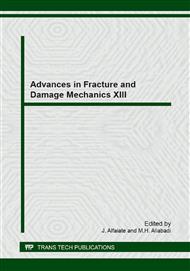p.337
p.341
p.345
p.349
p.353
p.357
p.361
p.365
p.369
Correlation of Dent Depth to Maximum Contact Force and Damage of Composite Laminates
Abstract:
A major concern affecting the efficient use of carbon fibre reinforced composite laminates in the aerospace industry is the low velocity impact damage which may be introduced accidentally during manufacture, operation or maintenance of the composite structures. It is widely reported that the contact behavior of composite laminates under low-velocity impact can be obtained under quasi-static loading conditions. This paper focuses on the study of the correlation of the dent depth to the maximum contact force and damage of composite laminates under quasi-static loading. Analytical and finite element simulation approaches were employed to investigate relations between the contact force and the dent depth. Experimental investigations on the correlation between dent depth, maximum contact force and damage include quasi-static indentation testing, optical and scanning electron microscopic examination of the damage under different loading levels. The effect of damage initiation and growth on the contact behaviour has been discussed. Results show that consistent correlations between the dent depth, maximum contact force and damage exist and can be predicted with the analytical and numerical approaches. Dent depth can be used as an engineering parameter in assessing the severity of damage for composite structures that are subjected to low-velocity impact. This may lead to the development of a cost-effective technique for the inspection and maintenance of composite structures in aerospace applications.
Info:
Periodical:
Pages:
353-356
Citation:
Online since:
September 2014
Authors:
Keywords:
Price:
Сopyright:
© 2015 Trans Tech Publications Ltd. All Rights Reserved
Share:
Citation:


